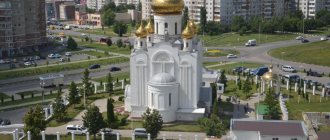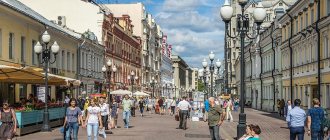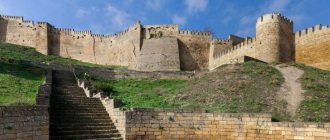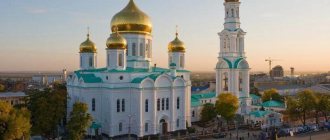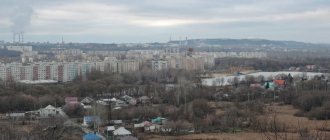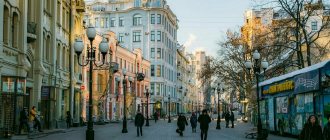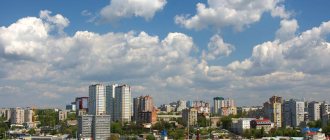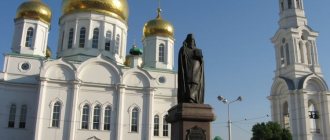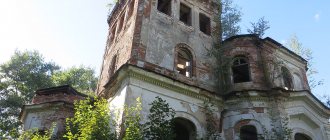From the editor: The history of the city of Dankov on the Don is still shrouded in secrets and replete with historical inaccuracies. The official founding date of Dankov has been set several times, and all of them are unfair.
The last date of formation, 1568, was imposed by the regional authorities; under its pressure, the year of formation of the city of Dankov was established (Before that, the dates were 1521 and 1523). I would like to hope that historical truth will prevail. Thanks to officials, Dankovites celebrated the 450th anniversary of the city twice, and this is from the realm of ignorance.
At least there is a document that mentions the year 1283. This letter contains a petition from the metropolitans of Kolomna and Ryazan to Tsar Ivan the Terrible, so that he would fairly judge the belonging of the Donkovo lands to the Kolomna, or Ryazan diocese. The Ryazan Metropolitan was able to provide documents dating back to 1283, but the Kolomna Metropolitan had no evidence. That is, in 1283 and earlier Dankov (Donkov) already existed and owned land plots. This is confirmed by the chairman of the Dankovsky Society of Local History, Ivan Fedorovich Malyukov. In the film “Donkovo Cossacks - Rising from the Ashes,” which can be viewed on this page below, there is an interview with Ivan Fedorovich.
It is worth mentioning the name of the city. The letter “a” appeared in the name in the 18th century, during the reign of Catherine the Second. Apparently the queen, a German by nationality, wrote Dankov, not Donkov, in one of the documents. It is clear that the officials did not dare to contradict the empress.
The word Donkov itself appeared thanks to the merger of two languages, Turkic and Old Russian. In Turkic “Don” is a river, and “kov” in Old Russian is a bend. That is, Donkov is nothing more than a place at the bend of the river. Indeed, the Don has a bend in the shape of a horseshoe, both at the current location of the city and at the Streshnevsky settlement.
Let us recall that the existence of Turkic tribes dates back to the 3rd-4th centuries BC. e. These times were marked by great events, for example, the beginning of the construction of the Chinese Wall and when our ancestors the Scythians captured Asian Sogdiana.
Based on archaeological finds on the territory of the Dankovsky district, we can safely say that the city of Dankov is the most ancient in the region.
The only question that arises is the location of the foundation. It is not yet clear where the Donkov fortress originally stood, on today’s site, or on the Streshnevsky settlement, 40 km higher along the Don. Since the fortress burned more than once and the city “moved.” But this situation cannot be taken into account either. After all, if a person’s house burned down and he built it in another place, this does not mean that someone, for their own reasons, should change his last name and year of birth.
The antiquity of Dankov is confirmed by archaeologist A. Levenok’s excavations of the Dolgovskaya Neolithic site near the village. Long, Scythian and Sarmatian burials, near the city of Dankov. These are also tribes of the 3rd-4th centuries BC. e. This means that this area has been inhabited and provided everything a person needs for life since ancient times.
Evidence of the importance of Dankov, which stood on the road to ancient Byzantium, is medieval maps. We give as an example a map of the late 16th century, where there is Donkov, but there is no vaunted and supposedly “ancient” Yelets. By the way, according to chronicle documents, Yelets was built by Donkovo Cossacks, that is, Cossacks. There is plenty of evidence that the Cossacks originated on the Dankov lands and nowhere else, watch the film below.
The map can be viewed in high resolution at this
.
Dankov, this is the story of a small town, the fate of which is similar to other county and later regional centers.
Official history of Dankov
According to official statements, the city of Dankov was founded in 1568 and was originally located on the left bank of the river. Don 30 km from the modern city. Built to protect the southern borders from attacks by the Crimean Tatars, it played an important role in organizing the Russian guard service.
Burned in 1618 by Hetman Peter Sagaidachny, Dankov was revived the next year, but in a new place. The city took its modern location on the right bank of the Don at the confluence of the river. Vyazovnya. The Dankov fortress with four roadways and two blind towers was located on a hill, at the beginning of the modern street. K. Marx. In the fortress there was a wooden cathedral church in the name of the Nativity of the Blessed Virgin Mary, a governor's courtyard, a hut, a well, and a cellar for storing weapons. Around the fortress there were Storozhevaya, Streletskaya, Cossack and Pushkarskaya settlements. On the right bank of the river. Vyazovny, at its very confluence with the Don, stood the Pokrovsky Monastery. Over time, the city lost its military significance; its fortifications became dilapidated and began to be dismantled. One of the fortress towers existed until the beginning of the 19th century.
Dankov
(Lipetsk region)
OKATO code:
42209501
Founded:
1568
Urban settlement since:
1941
City since:
1959 City of district subordination (Dankovsky district, Lipetsk region)
Center:
Dankovsky district
Telephone code (reference phone)
| 47465***** | 62-2-22 |
Deviation from Moscow time, hours:
0
Geographic latitude:
53°15′
Geographic longitude:
39°09′
Altitude above sea level, meters:
140 Sunrise and sunset times in the city of Dankov
Dankov history of development
According to the plan approved by the Emperor on August 31, 1780, the city of Dankov developed in a westerly direction. The administrative part, represented by wooden buildings of public places, a prison hut and a prison building, was previously located between two stone churches: the Nativity of the Virgin Mary Cathedral and the Church of St. Demetrius of Thessaloniki, according to the plan, is moved behind the Demetrius Church. Opposite the public places it was planned to build a magistrate and a guest courtyard. The city, divided into quarters, increased its area due to the partial annexation of settlements. The modern central part of Dankov, enclosed between the Don, Vyazovnya and st. Zastavnoy, corresponds to the plan of 1780.
Pre-regular plan of the city of Dankov, 1780s.
The process of rebuilding the city was lengthy. The stone two-story building of public places (K. Marx St., 7) and the prison castle were built only in 1835. The place designed in the plan for bread and wine stores was built up with a two-story building in 1842 (it is currently part of the Dankov hospital ).
In 1864, the city had 4 state-owned and 326 philistine houses (17 of them stone), 5 streets and three squares: Drovyanaya, Gostiny Dvor and Khlebnaya. In 1861-1878. On Khlebnaya Square, construction was underway on a new two-story stone cathedral in the name of the Tikhvin Icon of the Mother of God. Occupying a vast area in the city center, the cathedral is the dominant high-rise volume in the surrounding space and is perfectly visible from long distances outside the city. In the second half of the 19th - early 20th centuries. in Dankov, other stone churches are being built and rebuilt - in the name of St. Demetrius of Thessalonica, Nativity of the Blessed Virgin Mary, St. George the Victorious, St. John the Evangelist and the Nativity of Christ, which also became the main high-rise and architectural dominants of the city.
The city of Dankov in the mid-19th century. Market Square (now V. I. Lenin Square)
Economically, Dankov was not rich. From the description of the city in the mid-19th century, compiled by the city mayor, merchant V.I. Ermakov, it follows that “all 71 merchant families hardly have cash capital and goods, with the exception of houses, more than 400 thousand rubles, and therefore the wholesale trade of merchants cannot be placed on a par with the cities surrounding Dankov.” The city's commercial and industrial enterprises included 3 slaughterhouses, in which up to 15 thousand sheep were slaughtered per year, 9 grain crushers and butter churns, and two candle factories, which produced up to 800 pounds of tallow candles. Wholesale trade in Dankov was carried out only in bread. All other types of trade were defined as “insignificant”1.
With the construction of the railway and elevator in Dankov in the 1890s. the importance of the grain trade increased. At the end of the 19th - beginning of the 20th centuries. stone two-story houses of wealthy merchants P.D. appear in the city. Goleva, A.M. Shumilova, A.P. Lebedeva, V.G. Popova. They are still an architectural decoration of the city.
Also of historical and cultural significance are buildings that previously belonged to educational institutions: a state-owned men's gymnasium (now a children's art house and a planetarium), a private women's gymnasium and a higher city primary school (in Soviet times - a medical school), a religious school, which was located until 1870. in the Pokrovsky Monastery, and then in a specially built building (now secondary school No. 1).
Map
| Dankov: maps |
Dankov: photo from space (Google Maps) Dankov: photo from space (Microsoft Virtual Earth)
| Dankov. Nearest cities. Distances in km. on the map (in brackets along roads) + direction. Using the hyperlink in the distance , you can get the route (information courtesy of the AutoTransInfo website) | |||
| 1 | Lev Tolstoy | 20 (28) | IN |
| 2 | Lebedyan | 25 (34) | IN |
| 3 | Kurkino (Tula region) | 38 (52) | NW |
| 4 | Miloslavskoe (Ryazan region) | 41 (52) | NE |
| 5 | Red | 48 (151) | SW |
| 6 | Krivopolyanye | 52 () | IN |
| 7 | Chaplygin | 54 (60) | IN |
| 8 | Kind | 61 () | SE |
| 9 | Skopin | 68 (87) | NE |
| 10 | Efremov | 69 (70) | Z |
| 11 | Alexander Nevsky (Ryazan region) | 74 (117) | IN |
| 12 | Pervomaisky (Tambov region) | 75 (93) | IN |
| 13 | Stanovoe | 77 (116) | SW |
| 14 | Lipetsk | 77 (86) | YU |
| 15 | Ryazhsk | 79 (115) | NE |
| 16 | Tovarkovsky (Tula region) | 79 (98) | NW |
| 17 | Dace | 82 (113) | SW |
| 18 | Volovo (Tula region) | 82 (146) | NW |
| 19 | Bogoroditsk | 88 (110) | NW |
| 20 | Borinskoe | 89 () | YU |
| 21 | Kimovsk | 89 (118) | NW |
| 22 | Korablino | 93 (119) | NE |
| 23 | Novomichurinsk | 95 (127) | NE |
| 24 | Arkhangelskoye (Tula region) | 96 () | Z |
| 25 | Donskoy | 96 (133) | NW |
| 26 | Michurinsk | 97 (148) | SE |
| 27 | Zadonsk | 97 (162) | YU |
| 28 | Mud | 98 (115) | SE |
| 29 | Pronsk (Ryazan region) | 100 (120) | WITH |
| 30 | Izmalkovo | 100 (156) | SW |
| 31 | Petrovskoye (Tambov region) | 100 (190) | SE |
a brief description of
Dankov is located within the Central Russian Upland, along the banks of the river. Don, at the confluence of the river. Vyazovka, 86 km northwest of Lipetsk. Railway station. Road junction.
Territory (sq. km): 24
Information about the city of Dankov on the Russian Wikipedia site
Historical sketch
Dankov existed at the end of the 14th century, on the left bank of the Don, 34 km from the present city (near the modern village of Streshnevo). Here merchants traveling to Azov and Kafa (Feodosia) loaded their goods onto ships.
Founded in 1568 as a fortification on the site of the ancient Ryazan city of Donkov, destroyed by the Tatars. In 1618 it was moved to the other side of the Don at the mouth of the river. Vyazovni (Vyazovki). In the 18th century The Dankov form comes into use.
[Clarify the history of occurrence - sources give conflicting information].
Based on the position of the city on the river. Don and given the primary form of Donkov, the hydronym Don is usually seen as its basis. However, the formation of oikonyms on -kov from river names (Don > Donko > Donkov) has no analogues in Russian toponymy. The assumption about the existence of a tributary Donok (“little Don”) in the upper reaches of the Don, from which Donkov could have formed, is not confirmed by sources. Perhaps the basis is the personal name Danko (diminutive of Daniil), from which the name is derived using the suffix -ov.
Until the middle of the 17th century. a guard post to protect the Russian state from attacks by the Crimean and Nogai Tatars.
In 1708 it was assigned to the Azov province (from 1725 - Voronezh province), from 1719 to the Yelets province. Since 1778, the district city of the Ryazan governorship (since 1796 - Ryazan province). In 1796-1804 and 1925-41. village, Dankov - did not have city status.
In 1856, in the district town of Dankov, Ryazan province, there were 2 churches, 308 houses, 5 shops.
Since 1941, the working village of Dankov. Since 1959 it has become a city again.
Municipal indicators
| Index | 2001 |
| Demography | |
| Number of births, per 1000 population | 8.3 |
| Number of deaths, per 1000 population | 18.4 |
| Natural increase (decrease), per 1000 population | -10.1 |
| Standard of living of the population and social sphere | |
| Average monthly nominal accrued wages, rub. | 2147 |
| Average housing area per inhabitant (at the end of the year), sq.m. | 22.4 |
| Number of preschool institutions, pcs. | 8 |
| Number of children in preschool institutions, thousand people | 1 |
| Number of daytime educational institutions (at the beginning of the school year), pcs. | 7 |
| Number of students in daytime educational institutions, thousand people | 3.5 |
| Number of doctors, people. | 68 |
| Number of nursing staff, people. | 339 |
| Number of hospital institutions, pcs. | 2 |
| Number of hospital beds, thousand units | 0.5 |
| Number of medical outpatient clinics, pcs. | 2 |
| Capacity of medical outpatient clinics, visits per shift, thousand units. | 0.6 |
| Number of registered crimes, pcs. | 255 |
| Persons who committed crimes were identified, persons. | 239 |
| Economy, industry | |
| Number of enterprises and organizations (at the end of the year), pcs. | 253 |
| Construction | |
| Volume of work performed by type of activity “Construction” (until 2004 - volume of work performed under construction contracts), million rubles. | 33.7 |
| Commissioning of residential buildings, thousand sq.m. of total area | 7.1 |
| Commissioning of residential buildings, apartments | 91 |
| Commissioning of preschool institutions, places | 0 |
| Commissioning of educational institutions, places | 0 |
| Commissioning of hospital facilities, beds | 0 |
| Commissioning of outpatient clinics, visits per shift | 0 |
| Transport | |
| Number of bus routes (in intracity traffic), pcs. | 5 |
| Number of passengers transported by buses per year (in intracity traffic), million people. | 2.9 |
| Connection | |
| Number of residential telephone sets of the city public telephone network, thousand units. | 4.4 |
| Trade and services to the population | |
| Retail trade turnover (in actual prices), million rubles. | 205.6 |
| Retail trade turnover (in actual prices), per capita, rub. | 8675 |
| Public catering turnover (in actual prices), million rubles. | 13.3 |
| Volume of paid services to the population (in actual prices), million rubles. | 64.5 |
| Volume of paid services to the population (in actual prices), per capita, rub. | 2744 |
| Volume of household services to the population (in actual prices), million rubles. | 3.5 |
| Volume of household services to the population (in actual prices), per capita, rub. | 148 |
| Investments | |
| Investments in fixed assets (in actual prices), million rubles. | 83.7 |
| Share of investments in fixed assets financed from budgetary funds in the total volume of investments, % | 40.2 |
Data sources:
- Regions of Russia. Main characteristics of the constituent entities of the Russian Federation: statistical collection. Goskomstat of Russia. - M:, 2003.
Economy
Factories: chemical (production of varnishes, resins, oils, adhesives, sealants, catalysts, etc.), reinforced concrete products. Dolomite plant.
Food industry enterprises: meat and poultry processing plants, starch factories, dairy factories, bakery. Sewing factory "Cosmos".
Potatoes, sugar beets, and grains are grown in the Dankovsky district. They raise cattle, sheep, pigs, and poultry.
Deposits of dolomite, sand, clay.
Main enterprises
CHEMICAL INDUSTRY
JSC "Silan"
399820, Lipetsk region, Dankovsky district, Dankov, st.
Zaitseva, 14 Offers:
Synthetic resins and plastics
Culture, science, education
Local history museum and art gallery.
Museums, galleries, exhibition halls
Dankovsky Museum of Local Lore 399820, Lipetsk region, Dankovsky district, Dankov, st. Karla Marksa, 3 Phone(s): (47465) 6-6126
Architecture, sights
The old part of Dankov is located on the right bank of the Don and has largely preserved the appearance of a district Russian town of the late 19th century. Church of Dmitry of Thessalonica (1760s, early classicism; now a local history museum).
10 km from Dankov, in the village of Balovnevo, Vladimir Church (1799, designed by architect V.I. Bazhenov).
45 km from Dankov, in the village of Polibino, is the ensemble of the former estate of the Nechaev-Maltsevs (late 18th century).
| Population by year (thousands of inhabitants) | |||||||
| 1856 | 3.3 | 1989 | 24.7 | 2006 | 22.4 | 2015 | 19.6 |
| 1897 | 9.1 | 1992 | 24.7 | 2007 | 22.3 | 2016 | 19.3 |
| 1913 | 10.4 | 1996 | 24.8 | 2008 | 22.3 | 2017 | 19.1 |
| 1939 | 2.9 | 1998 | 24.6 | 2010 | 22.0 | 2018 | 19.0 |
| 1959 | 12.7 | 2000 | 24.1 | 2011 | 21.1 | 2019 | 18.8 |
| 1967 | 18 | 2001 | 23.7 | 2012 | 20.7 | 2020 | 18.7 |
| 1970 | 20.0 | 2003 | 23.2 | 2013 | 20.2 | 2021 | 18.6 |
| 1979 | 23.2 | 2005 | 22.6 | 2014 | 19.9 | ||
How to get there and where to stay
The city of Dankov has a convenient geographical location in terms of transport accessibility: between two major highways M6 and M4. You can get to Dankov by turning off these roads onto P-126. From Lipetsk to Dankov there is Lebedyanskoye Highway, highway R-205.
From Moscow, buses regularly run here from the Paveletsky station and the bus station at the Shchelkovskaya metro station, as well as train No. 31 to Tambov (you need to get off at the Ranenburg station and take a commuter bus).
There are two hotels in Dankov: “Silan” at the chemical complex, but judging by the reviews, they are far from exemplary.
Lebedyan is a beautiful small town
The population is constantly declining; since 2011, there has been an outflow of more than 1,000 people. For the city, the authorities came up with an amazing solution considering the extremely small area.
In 1989, construction of the metro began. The initiator was Leonid Mulyarchik. With the support of local municipalities, he began digging a tunnel, which now reaches only 200 meters. However, experts confirmed that the structure is reliable, but now the metro is officially closed and blocked. Its construction continued until 2011. Lebedyan is characterized by a problem with a shortage of medical personnel, which applies to many settlements in Russia. There is a “Health” program here, but its implementation is at a mediocre level.
Gryazi - industrial town
Mechanical engineering has become a city-forming industry for the city of Gryazi. The settlement plays an important role, being a major railway junction connected with Moscow, Rostov, Orel and Volgograd.
The population is provided with work, but has problems with infrastructure. Housing and communal services require serious improvement measures. The city has kindergartens, private schools, and an art gymnasium. The general situation in Gryazi is typical for any regional city that has a relatively good level of improvement. Young people often leave Gryazi to go to millionaires to look for education and work.
City of Dankov
I am glad to welcome you to the glorious and ancient city of Dankov, through which we will make our journey.
The history of the city goes back to the distant past. It is difficult to imagine that many centuries ago the sabers of the Crimean and Nogai Tatars rang here. The city, surrounded by wooden walls, bravely repelled the foreign hordes. The Dankov fortress was located to our left, on the site where the district hospital complex is now located. For about 150 years it was a staunch outpost, honestly carrying out its military service, and defended the borders of the Moscow state from the Wild Field. The cathedral church of the Nativity of the Virgin Mary stood here. The year of the consecration of this cathedral - 1653 - began to be considered the year of the founding of our city.
But the first settlement on the site of Dankov in the 16th century. was still not a fortress, but
a monastic monastery founded by Roman Nikitich Telepnev, according to legend a disgraced boyar, the son of Elena Glinskaya’s favorite, who fled to the dense Dankovo forests from the terror of Ivan the Terrible, but this legend is not confirmed in historical chronology. Schemamonk Roman's hermitage, which consisted of a cell and a chapel, was located on the right bank of the Vyazovnya at its confluence with the Don. (We are now passing by this place). The fortress was erected later, next to the already existing desert. For a long time, Roman Nikitich lived here in solitude, spending days and nights in prayer, until he found followers with whom he founded the Intercession Monastery. Next to the monastery there was the Church of the Nativity of Christ (you see this temple), it cared for the residents of Storozhevoy Sloboda. After a long period of neglect, the church became operational again in 2006. But let's return to the history of the Intercession Monastery. We know that on its territory there were 2 stone churches, a stone 2-story building housing a religious school, a two-story house for cells, a well, a bathhouse, a garden and a vegetable garden. Above the grave of the founder of the monastery, first a wooden and then a round stone chapel of beautiful architecture was built. The Intercession Monastery was surrounded by a fence. The Dankovites prayed to Schemamonk Roman for rain and lack of rain, for deliverance from the epidemic; memorial services were held at his grave and numerous cases of miraculous healings were recorded. The monastery was closed in 1924. In 1929 it was dismantled for the construction of a starch factory. Currently, this territory has been transferred to the ownership of the Lipetsk and Yeletsk diocese for the restoration of the destroyed shrine on this site. The Intercession Monastery will be rebuilt here, and a monastic monastery will again appear in our area.
Many events in our history are being interpreted in a new way. But one thing remains unchanged - the feat of the defenders of our Motherland. On June 22, 1941, Nazi Germany attacked the Soviet Union. Already on July 4, 1941, a meeting of workers took place in the city of Dankov on Lenin Square, at which many decided to volunteer for the front. The enemy came close to the borders of the Dankovsky region, Efremov, Chernava, Skopin and Yelets were occupied. In the occupied territory, the Nazis carried out merciless terror: the invaders shot prisoners, subjected our people to cruel torture, carried out mass robberies and destruction of cultural and economic objects. Hundreds of men, women and children of the Lipetsk region were sent to hard labor in Germany, where many of them died from backbreaking labor and torture. Our city was not occupied, but the borders of the district coincided with the front line. In October 1941, enemy planes bombed Dankov, and in November the enemy was 30-45 km from the city. There was a threat of occupation. All citizens immediately began defensive work: barricades were erected from stone, anti-tank ditches were dug. The city was preparing for defense. Only thanks to the success of the Yelets operation, Dankov was saved; the enemy retreated, leaving 400 settlements behind. Residents of the city and region did everything possible and impossible to help the front: they donated money, women’s tractor brigades were created, warm clothes were collected, women and teenagers had to master male professions in order to replace men who had gone to the front, pensioners returned to their jobs. Dankovites worked in hospitals, where the first wounded began to arrive in June 1941. In 1941 - 1942. The military unit and the population quickly built concrete platforms for military aircraft. This is how the airfield appeared. In July 1942, the 778th air regiment of dive bombers arrived in Dankov. The planes of this regiment flew out to bomb enemy fortifications around the clock. Before you is a monument to military pilots who died in the skies over Dankovskaya land, erected on the initiative of our fellow countryman, Hero of the Soviet Union, Major General of Aviation A.
Vishnyakov Ivan Alekseevich (1917-1992) - a native of the village of Trebunskie Vyselki, Dankovsky district. Before the war, he worked on a collective farm as an accountant, mechanic mechanic, metro builder in Moscow, and, after graduating from aviation school, as an instructor at a flying school in Bataysk, where he met the later famous Alexei Maresyev. He went to the front in July 1941. He fought as part of a combat squadron of a fighter aviation regiment. During the war years, Major Vishnyakov flew more than 300 combat missions. Conducted 100 air battles and shot down 20 enemy aircraft personally and 3 in group battles. In addition, during the attack, he, as part of a group, destroyed 19 enemy aircraft at airfields. Participated in the defeat of the Japanese militarists. Quite recently, in the Dankovsky district, in the hero’s small homeland, a memorial sign was unveiled on the site of the house where this wonderful man was born.
Since navigation along the Don began from Dankov, Dankov merchants flourished. They loaded their boats with honey, wax, furs and sent it all to Azov, Kafa, and Constantinople. They returned back on ships loaded with salt, paper and silk fabrics, spices, wines, beads, gold, silver, horses and other goods. Along the Don, in addition to merchants, embassies of different countries and clergy, accompanied by guards, sailed with goods. Movements along the Don were often hindered by robbers. The area along the banks of the river was very convenient for them: all around there were dense forests, dug by deep ravines. There is a lot of game in the forests, there is a lot of fish in the Don. It is not for nothing that the people have preserved legends about robbers. On such a small section of the river, from Dankov to Lebedyan, 3 gangs of robbers ruled. In the Lebedyansky area Tyapka was the ataman, in the vicinity of Dankov - the robber Anna, and in the area of the village. Long - Kudeyar the Robber. Their gangs were so strong that significant military units were sent to liquidate them. The ravine that goes to the Don near the village. N. Nikolsky on the right side of the river, in memory of the atamansha, it is called Annin Verkh, because in the 15th century this ravine was the hangout of the robber Anna. From its steep heights, she watched the approach of water trading caravans and rushed to ambush them with her accomplices. The merchants, who had safely passed Annin Verkh, served thanksgiving services. The Don Cossacks finally took up arms against this Anna, whose fame had spread throughout the Don. Having learned of their approach, Anna buried her treasures in the ground and entered into a battle with the Cossacks, which ended in her favor, but, avoiding a secondary attack, she went deep into the surrounding forests. The Cossacks came unhindered to Annin Verkh and, not finding any booty here, went further to the city of Kudeyara. Another legend says that Anna, surrounded by Cossack troops, went into a nearby forest and hanged herself there, not wanting to be in the hands of the Cossacks. (This is where the name of the Dankovskaya, now Pushkin Grove, came from - the Visly Forest.) Having reached the Kudeyarov fortress (on the left bank of the Don, below Osinovaya Gora, where the village of Dolgoye is now), the Cossacks besieged it for a long time and finally decided to cover it with brushwood and light it with all sides. Popular legend says that Kudeyar buried all his treasures in the ground, placed his favorite horse over them, turning it to stone so that it would not burn, and he fled into the forest. But the Cossacks chased after him, took him prisoner by cunning and, shackling him, threw him from the Black Yar to the Don.
Now we are at the church of Streletskaya Sloboda Dankov. This is the oldest building, preserved from 1760 (year of construction) - the Church of Demetrius of Thessalonica, one of the most revered Russian saints. For almost 2 centuries she cared for the surrounding residents. But in the 30s. XX century was plundered, its bell tower was destroyed. The church turned into a salt storage facility. And only in 1969 our local history museum was located here, which we will visit a little later.
On the left side in the direction of movement you see a monument to the defenders of the Fatherland (made of granite), on which the following words are written: “Eternal memory and glory to the defenders of the southern borders of the Russian state of the 16th-17th centuries.” This memorial sign, installed in 1994, symbolizes memory and tribute to the ancestors who founded our city, to those who carried out difficult service in the Dankov fortress, repelling 8 attacks by the Tatars. With the weakening of the danger of military attacks, Dankov gradually lost the appearance of a fortress city; its service people founded settlements and took up farming.
On the left side in the direction of travel there is a post office building. Here on this site in the pre-revolutionary period there was a Dankov prison.
Having turned into a merchant-philistine town, Dankov was famous for its fairs. In the center of the city (the place we are now passing) there were shopping arcades, a market square where they sold bread, traded handicrafts, industrial goods, and horses. Market days were held on Sundays and Fridays every week. The amount of annual turnover of city fairs was determined at 100 thousand rubles.
We entered the old part of the city, where stone buildings from the late 18th and 19th centuries have been preserved. The most important attractions of our city, undoubtedly, are the temple architectural monuments. These are mainly stone churches from the 19th century. All buildings in the city were wooden and were easily subject to frequent and severe fires. Thus, a Polish rebel who was serving exile in our city, out of a sense of revenge, burned out almost the entire city, setting it on fire 17 times. On the 18th arson, the criminal was caught, sentenced to lashes and exile to Siberia for hard labor. Residents of the city vowed to build a cathedral at their own expense if the fires stopped. The promise was kept. A beautiful architectural monument appeared on Bread Square, which can be seen from anywhere in the city. The Tikhvin Cathedral is named after the Tikhvin Icon of the Mother of God - the guardian from the destruction of fire. The construction of the temple was completed in 1878. Next to it stood a 5-tier bell tower, destroyed in the 30s. XX century. Some old-timers claim that during its explosion, the glass of neighboring houses flew out, which saved the cathedral itself from the barbarity of the new government: it remained intact, because they were afraid that a more powerful explosion would cause even more damage. For a long time the temple remained ownerless or was used as a warehouse. But now it is the most beautiful building in the city. For more than 10 years now, the Tikhvin Cathedral has been active and has a large parish. The fence was recently restored based on a photograph from the museum’s archives.
On the right, near the district administration building, you can see one of the merchant houses with its unique architecture. It was built back in the 19th century by the merchant Sergei Sergeevich Peshkov. Peshkov lived in the house alone with his daughter. The lower floor was occupied by manufacturing stores. In 1909, a women's four-year private gymnasium was opened in the building, which occupied the entire top and existed here until the October Revolution. The lower floor of the house was occupied by shops: for example, there was a “Shop of Beautiful Goods”, and a “Consumer Society” was located here. Now the building belongs to the city medical school.
At the moment we are passing by the building of the former People's House, where in 1919 the “All-Union Elder” Mikhail Kalinin spoke.
Our bus is approaching the next temple architectural monument - another active church in the city - the Church of St. George the Victorious. St. George's Church belonged to the Cossack settlement of the city. From salary books we know that a wooden church stood on this site back in 1676. In 1791 it burned down. Ten months later, parishioners bought a new church in Urusovo. They transported it in parts, restored it, and after consecration in 1823, services were resumed here. But it was short-lived, the building became dilapidated and began to collapse. The Dankov merchants allocated funds, and in 1857 a real church with chapels of the martyr Alexander and Mitrofaniy of Voronezh began to be built. It was consecrated in 1872. This time is considered the year of birth of this beautiful monument of church architecture.
And now we are going to Uritsky Street. Of course, you are familiar with the name of Moisei Uritsky, chairman of the Petrograd Cheka, after whose murder the Bolsheviks declared the “Red Terror”. Previously, this street was called Pochtovaya, because the Dankov post office was located here.
On the left in the direction of our movement you see the merchant house of Lebedev, one of the Dankov grain magnates. In 1818, the Dankovsky district executive committee was located here (the Dankovsky district committee of the RCP (b) was first created after the establishment of Soviet power in Dankov).
During our excursion I already mentioned the term “sloboda”. You and I drove through Cossack with the parish in the St. George's Church, Streletskaya with the parish in the Church of Dmitry of Thessaloniki. Now we are heading to the settlement of theological Cossacks.
You have a view of the Bogoslovskaya Sloboda temple. This is the Church of St. John the Evangelist. It was listed in salary books already in 1676. It was rebuilt several times and already in the 19th century. took on its current appearance, becoming a stone structure. In the 30s this temple was closed, the bell tower (?) was destroyed, the bells, all icons and iconostases were destroyed. The temple building was first used as a granary, a kerosene store and a grocery store. As soon as meat began to be sold here, extraordinary phenomena began, and the store was forced to close. In 1997, the temple was transferred to the Church, but only in August 2003 did regular services begin here.
The Cosmos clothing factory, to which we are now heading, is still afloat and produces its products on orders from enterprises and organizations, both Russian and foreign. The central market of our city is also located here.
We are heading in the direction of the Dankovo station. The railway in Dankov appeared in connection with the need to transport bread from our grain district. It was no coincidence that I called the merchant Lebedev I mentioned earlier a grain magnate. He was the owner of the largest steam mill in the area. By the way, such merchants exported more than 1,000,000 poods from the district. It is not for nothing that in 1890 an elevator was built (we are entering its territory) for 200,000 poods, and a railway was connected to the city. Previously, horse traction was used.
After the revolution, from a trading and merchant town, our Dankov turned into one of the industrial regional centers of the region, into a city of miners, builders, power engineers and, of course, chemists. It was once called the city of “big chemistry.” After all, the Dankov chemical industry is the first-born of the organosilicon industry of our country. We are approaching the plant management building of the Dankovsky Chemical Plant, now JSC Silan. Next is the factory entrance, and behind it are numerous buildings where more than 70 types of products are produced. These are: varnishes and resins, oils and liquids, emulsions and catalysts, and even medicines. The importance of this product is difficult to overestimate. It is used in a wide variety of sectors of the national economy as heat-resistant and frost-resistant materials. The use of even the simplest silicon-organic products significantly saves materials and frees up labor. The products of this enterprise are supplied to 4 foreign countries.
Lenin Street, along which we are passing, is the central street of the new city, which appeared on the left bank in the post-war period. And this area began to be built up in the early 30s. XX century in connection with the opening of industrial enterprises: a dolomite plant, a reinforced concrete plant, and, above all, a chemical plant. The 4-5-story Khrushchev-type buildings you saw appeared thanks to the latter.
By the beginning of the twentieth century. In the city there was a zemstvo hospital, a 4-grade higher primary school, 2 secondary educational institutions, a state-owned men's and private women's gymnasium. There was a fee for studying there. There was no large industry in the city. Now there are 11 industrial enterprises and 7 construction organizations operating here. At the service of Dankovites and guests of the city are 2 Houses of Culture, the Don cinema, 2 hotels, libraries, a museum, an art gallery, and the only regional planetarium in the Lipetsk region. There are 6 secondary schools, 8 children in Dankov. gardens, music school, art school, boarding school, evening school, medical school. school, vocational school-9, sports. school, sports. Khimik stadium complex, swimming pool. In addition, the population has a central clinic, a hospital, and a dental clinic. And Dankov’s children and teenagers can find use for their abilities and talents at the Children’s Creativity Center.
In front of you is a cast-iron stele - an exact copy of the monument to the soldiers of Dmitry Donskoy, located on the Kulikovo Field, on the top of the Red Hill. It was erected according to the design of academician A.P. Bryullov.
From the stepped quadrangular platform, a powerful trunk of a column appears to grow, divided in height into five tiers.
The total height of the monument is 28 meters, it weighs 428 tons.
The column was cast in parts at the St. Petersburg plant and brought to the Kulikovo field on a special sleigh.
In one of the niches there is an inscription: “To the winner of the Tatars, Grand Duke Dmitry Ivanovich Donskoy, grateful offspring. Summer of 1848." The monument was solemnly opened on September 8, 1850.
This entrance sign is the calling card of our city, because once upon a time the field of Russian glory belonged to our region.
Now we are passing the territory of the former Kulikovsky state farm; at the moment this area falls within the city limits. The name of the ancient country settlement “Kulikovka” comes from the distant past, when in the dense local forests there were many waders (as is known, this is a marsh bird that often lives along the banks of rivers).
Soon we will find ourselves on the territory of Pushkarskaya Sloboda. Here, not far from the Dankov fortress (beyond the Don), gunners and their descendants lived. Nowadays it is the central thoroughfare of the city, Mira Street. Here, on the left bank of the city, there is another memorial and an artillery piece installed in honor of fellow countrymen who died during the Great Patriotic War. The author of the memorial complex is. During the Second World War, our city lost 7,365 people (about seven and a half human lives). This is almost half of all those called up to the front. Every year on the day of the Great Victory, veterans and young Dankovites gather here to honor the memory of their fellow countrymen.
On the right in the direction of our movement you can see a monument to the pontooners of the 131st special motorized pontoon bridge battalion. It was in our region that this glorious unit was formed in 1942; the battalion headquarters was located in Dankov and from here it began its combat journey throughout Europe. You see the monument itself - a boat - and on the pedestal - the military route of the unit: from Dankov through Warsaw, Berlin, Potsdam, to Grodno and Mosel.
We are approaching the oldest building in Dankov. The city's local history museum is located here, and I invite you to visit its walls.
……………………………………………………………………………………………………
Before you is an open-air museum. And its first exhibit is dolomite from the Dankovsky quarry. Dolomite was formed in a shallow sea that covered the territory of the Lipetsk region for 80 million years. As a result of the death of shells of mollusks and other marine animals, calcareous silt settled in layers, which, under conditions of high salinity, turned into dolomite. It contains up to 20% magnesium and up to 50% calcium. But here’s another exhibit – limestone. It was brought from the Khmelenetsky quarry in the Zadonsk region. Outwardly, it is not much different from dolomite, but it is pure lime. We approach a large piece of iron ore from the Kursk magnetic anomaly. This is ferruginous quartzite - a low-grade ore containing 26-46% iron. About 100 thousand years ago, a glacier from Scandinavia brought these huge boulders to our land. A unique pile of large boulders is located in the Panika ravine. The movement of the huge mass of the glacier was stopped by one of the elevations of the Central Russian Upland, which it did not overcome and remained forever on the Dankovo land.
Our city tour is over. Thank you for attention!
Old Dankov near Streshnevo
So, the old city of Donkov existed. There is no doubt about this and there cannot be. The famous Soviet scientist archaeologist A.L. Mongait in his study “Ryazan Land” also testifies that “The Old Donkovskoe fortification is the remains of a city of the pre-Mongol era...” During excavations at the old Donkova fortification near the village. Streshnev Leningrad archaeological expedition with the assistance of Dankov local historians, under the leadership of archaeologist Vsevolod Protasyevich Levenko, discovered objects of the 12th-16th centuries in 1959, which confirms the conclusion of historians.
Old Donkov was a fortress city and at the same time was of great importance in terms of trade: it was the most important pier on the Don. Shipping began from here, ships were built right there, goods were loaded onto them to be sent to Kafa, Azov, Constantinople and other cities of the Black Sea region. Russian merchants brought honey, wax, cloth, spicy roots, wines, fruits, beads, silver and gold items, weapons and other goods abroad.
Old Donkov repeatedly had to repel the attacks of detachments of the Tatar hordes, which for 300 years interfered with the peaceful work of the villagers with their unexpected predatory raids; more than once it was subjected to fire and destruction. And after 1521, when the city was completely destroyed, it was no longer restored in its old place. They did not do this, obviously, because the borders of the Moscow state moved far to the south. By that time, the Don had become so shallow that navigation along it from the old Donkov had ceased, and further down the river they found a convenient place for the construction of a new city, which in its natural conditions was better than the previous one.
Monument to old Donkov
Monument to old Donkov near the village of Streshnevo, on the site of the old fortress
In 1993, a monument stone was erected at the old Donkov settlement with the inscription: “Here stood the border fortress of old Donkov until 1521.” Not far from the monument, a well with a canopy in the old Russian style was built.
All this was built at the expense of the Dankovsky Dolomite Plant, whose general director is Fedor Vasilievich Korlykhanov.
New Dankov was built as a fortified military outpost on the state border. It became a necessary link in the system of border fortifications, called the Belgorod abatis line. This fortified strip protected the southeastern and southern borders of the Moscow state from the raids of the Crimean and Nogai Tatars, who, since the 13th century, had been roaming in large hordes and small detachments across the vast steppes around the Don and its tributaries.
The defenders of the Donkov fortress took water from this well.
Dense forests then grew here, and the steppes were covered with grasses as tall as a man, in which it was easy for enemies to hide and make surprise attacks on Russian villages. They burned cities and villages and plundered property. Whoever resisted them, they killed. Thousands of people were taken captive and sold like cattle into eternal slavery. To prevent the Tatars from penetrating Russian possessions, fortified cities were built on the outskirts of the state. Such a fortress city was the new Dankov, to which Dmitry Lyubavsky dedicated his poem:
On a high steep slope at the confluence of rivers, the town was built by a Russian man.
He created towers and walls, planted archers, gave the town a name - Dankov.
Boldly rising above the steppes, the fortress guarded both Moscow and Rus'.
The fortress guarded the peace of the Motherland, proudly towering above the Don River.
The infidels - the Tatars - will be given a lesson; they will not allow fires to burn their home.
The cruel enemy will disappear. Rus' will bloom. Rus' will henceforth grow stronger and stronger.
From that time on, people began to settle in the area. I knew that now they wouldn’t let us offend them...
Happiness and adversity Turned into dreams The years of Ancient antiquity faded away.
2 things to do in Dankov
- Go to the planetarium - it’s the only one in the entire region, and here at any time of the year you can look at the constellations of both hemispheres and the starry sky of different latitudes. It was founded in 1975 by a lecturer at the capital’s planetarium, Ivan Shevlyakov, who was born in Dankov. The scientist became famous for his revelations: several of his works are dedicated to charlatan ufologists; in the Dankov Planetarium in memory of his fellow countryman, he still gives a lecture to everyone on the topic “The Universe and UFOs.”
- Visit the “small Tretyakov Gallery” - that’s what the locals call their art gallery. It is located in the local history museum, which in turn is located in the Church of Dmitry of Thessalonica. The exhibition includes original works by Serov, Korin, Deineka, Grabar and other artists.
Lipetsk is a densely populated city in the central Black Earth Region.
Over the past ten years, there has been a significant outflow of the population, but people themselves say that many return here after a long stay in Moscow, where they are looking for decent earnings. Most Lipetsk residents need to move to the capital, with its attractive prospects, to save money to buy a home. Meanwhile, there are many problems with housing and housing and communal services. The list is quite long, but it can be boiled down to a few main difficulties.
In some areas, the population density is so high that utility services simply cannot cope with the maintenance of homes. Lipetsk is located in a climatic zone characterized by a sharp onset of winter. A large number of cars and sudden precipitation often lead to transport collapse. An insufficient number of snow removal equipment cannot provide the desired benefit. Yard cleaning is often completely forgotten.
The wear and tear of the heating mains regularly used by residents forces repair and restoration work to be carried out twice a year. Moreover, sometimes services do not do their job at all, which causes the infrastructure to suffer even more. Throughout the Lipetsk region there are not enough kindergartens and schools. In 2022, local authorities took many actions to correct the problem. So far, this only works in relation to new microdistricts where the construction of corresponding municipal institutions is underway. Electronic child registration plays a useful role, allowing residents to determine the child's position in the queue. There is also compensation, which is 5,000 rubles. — such a payment awaits everyone whose children were unable to get into kindergarten and were forced to continue to wait (valid for children from 3 to 6 years old).
Yelets is a small town
Yelets never aspired to become big. This settlement is specially created for tourists, so local authorities are trying to develop the infrastructure. The authorities are undertaking various programs that are designed to regulate tariff rates for:
- gas;
- water;
- electricity supply;
- housing maintenance;
- improvement of housing stock.
The results generally please the townspeople, who receive playgrounds and landscaped courtyards. Moreover, for this they do not have to overpay significantly, since there are still the same well-thought-out tariffs.
There are practically no traffic jams in the city. However, due to the one-way traffic that prevails here, you may encounter slight congestion. The city has a sufficient number of schools and kindergartens, but many of them are paid. Residents of Yelets are employed in trade enterprises. Nowadays, catering establishments often begin to open in the city. Therefore, there is enough work, but finding employment can be difficult.
